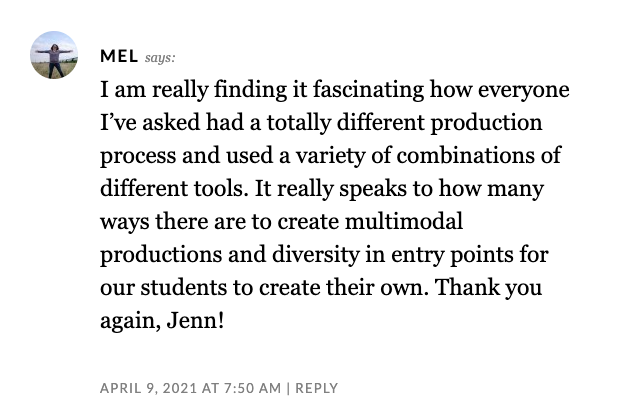Digital Games by Jennifer L.
View Jennifer’s Original Task
View Jennifer’s Modebending Task
Production and Tools
I was curious and unsure about how Jennifer approached producing this video because I’m not familiar with the Nintendo Switch and its capabilities. Did she record her screen with another device? Can you screenrecord on the Switch? So I asked her, and she responded:
I used the video capture option but the downside to that is it can be max 30 seconds long, so I took about 5 videos. You can transfer over images/videos via QR code on the switch so I sent it to my phone, then airdropped it to my computer (lmao seems so onerous in hindsight! but it was pretty easy and quick). I pieced it all together in iMovie, and then did the voice over using Voice Memo on iphone (no script, so I had to do a few takes), and airdropped that audio file, and imported it into iMovie. That’s about it! Oh, and the video ‘title card’ I whipped up using photopea.com
Jennifer created this demo by screenrecording within the Switch and bringing it into other content-authoring software to finish it off. Across everyone’s modebending task, I have been pleasantly surprised that everyone’s process and production tools have been different, and I let Jennifer know this:

In the Breakout of the Visual, Bolter discusses how technology levels the playing field for novices who want to produce texts, and though he’s discussing digital publishing of print text, the ideas about the ease design and production are still valid across multimodal text productions:
In the 20th century, digital technology in the form of desktop publishing and computer-controlled photocomposition refashioned the practice of printing, and in comparison with the earlier mechanical techniques, digital printing seems to foster heterogeneity in both form and content. One reason is that the computer opens the printing process to small groups and even individuals. Amateurs can create their own camera-ready copy and make selective use of or ignore altogether the stylistic practices of professional typographers. (2010, p. 49).
Jennifer says she “whipped up” the title card for her video using photopea.com, just as I used canva.com to create the images with text overlay on my linking assignment page as a workaround to not being able to figure out text hovering within WordPress.
Literacies & Theories
Jennifer’s experience playing Animal Crossing is valuable because the game is so popular it has become a social, cultural, and political phenomenan, and gives her a kind of gamer cred and capital I don’t possess because I’ve never played the game. Jennifer has access to another lifeworld and extension of her real-life identity through her Animal Crossing character. When she enters the virtual game world of Animal Crossing to curate her bag, Jennifer is limited by the objects in the game to some extent, as she cannot create her own objects from scratch. She overcomes this by assigning meaning to her chosen objects to represent other things. In the case of my selection of sound effects, I was also limited in what sounds were available to me in GarageBand however, theoretically I had the power and resources to create my own sounds from scratch, but found it easier to use existing sounds. Both Jennifer and I used a similar process of my assigning our own meaning to the sounds and objects we used. In doing so, we both overcame the material constraints of our content-authoring tools to make and disseminate meaning in our productions that convey our intended messages and meaning, as well as reveal our identities and life-worlds, which were the intended outcomes of the modebending task. (Kress, 2010, p. 185).
In her own words, Jennifer discusses how digital games are an important opportunity for students to experience multimodal texts and how the playing and production within them is valued literacy in her classroom:
“The increasing saliency of cultural and linguistic diversity and the multiplicity of communications channels and media” require us to redefine what literacy means to us now (Group, 1996, p.63). Literacy then, is not just language but a social practice that encapsulates multimodal meaning-making. This can include involving the visual, audio, spatial, and behavioural. For students, creating videos or producing small pieces of media to represent understanding falls under this new definition of literacy. It makes sense. The way students have taken ownership over their media consumption and production necessitates that we as educators address this. Rather than asking students to just tell me about themselves in a letter, activities such as these also help with teaching students what literacy means and open up avenues for them to show understanding in future assignments.”
References
Bolter, J. D. (2010). Writing space: Computers, hypertext, and the remediation of print (2nd ed.). Lawrence Erlbaum Associates. doi:10.4324/9781410600110
Kress, G. (2010). Multimodality: A social semiotic approach to contemporary communication. Routledge.
The New London Group. (1996). A pedagogy of multiliteracies: Designing social futures. Harvard Educational Review 66(1), 60-92.